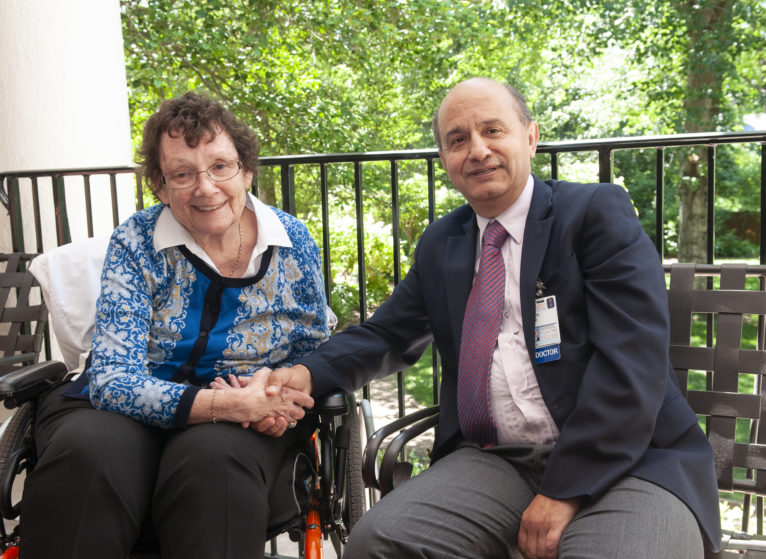Joanne Walsh was always the “brainy one.” She had a mind for math that led her to a career at NASA. There, she was an aeronautical and mechanical engineer for over 30 years. Finding solutions to complex problems — this was always second nature to her.
Today, however, the 72-year-old retiree is facing a problem for which there is no clear solution. Joanne has glioblastoma (GBM). This aggressive and incurable form of brain cancer is one of the hardest cancers to treat, according to the National Brain Tumor Society.
If it sounds familiar, that’s because glioblastoma has been in the headlines a lot in recent years. It took the lives of Senator John McCain in 2018 and Beau Biden in 2015.
An Unusual Path to a Brain Tumor Diagnosis
For Joanne, the first sign of a problem was a drop foot or difficulty lifting the front part of the foot. This was followed later by a heavy feeling in her left arm. “I wasn’t sure where to start,” she says. Joanne eventually went to an orthopedist in Newport News, her hometown.
The doctor’s diagnosis: a pinched nerve. The orthopedist scheduled her for a spine surgery to relieve her symptoms. But during recovery, Joanne’s condition didn’t improve. It got worse.
A CT scan revealed that it wasn’t a pinched nerve causing her symptoms after all. It was a tumor on the right side of her brain. “They called in a neurologist who told me that I had five weeks to live if I didn’t have the tumor removed,” says Joanne. “He said I should make my bucket list.”
Two days later, Joanne had brain surgery to remove the tumor. “The surgeon got as much of the tumor as he could, but he couldn’t find the root of the tumor. He was afraid to do too much damage,” she says.
According to the Glioblastoma Foundation, this is one of the biggest challenges in treating glioblastoma. The cancer invades the brain, so it’s difficult to remove the entire tumor. Any cancer cells left behind grow quickly and spread.
Dedicated Trio Offers Cancer Support
Joanne’s brain surgery and lengthy recovery that followed was just the first step. She quickly learned that her GBM treatment would be infinite and challenging. It wouldn’t cure her.
Instead, the goals were to help relieve her symptoms, maintain her quality of life and, hopefully, prolong her life. Fortunately, Joanne didn’t have to face this difficult prognosis alone.
“Jane [Dodge] and Frances [Klovstad] wrote me letters after they found out about my diagnosis, but I didn’t want anybody to see me in the condition I was in,” says Joanne.
“The three of us were friends in high school,” Jane says. “Joanne taught me how to dance for the prom. She was the smartest person I ever met. But we all went our separate ways. Joanne went to NASA, I was teaching, and Frances was traveling around the world with her husband in the Air Force. When I found out Joanne had cancer, I tracked her down, and I wrote her cards of encouragement. Finally, one day, she picked up the phone and called me.”
From that point on, Joanne had a team to help her navigate the new reality of living with aggressive brain cancer. In addition to Jane and Frances, Vici Thornton, a former student in Joanne’s water aerobics class, eagerly volunteered to lend a hand. During the late-night fever spikes and hair loss, when a wheelchair became a necessity and the doctor visits multiplied, all three friends were there for her in different ways.
“I help with the healthcare, and Francis helps with the financial stuff. Vici is the young one and she does a lot of the heavy lifting. We stay very busy,” says Jane.
Teaming Up to Advance Glioblastoma Treatment
Joanne had her first appointment at UVA Cancer Center with neuro-oncologist Camilo Fadul, MD in 2018. “That was a big milestone in her treatment,” Jane says. “It takes 2 1/2 hours for her to get there, but there’s just no other facility like it.”
“I didn’t have trust in a lot of doctors, but I trusted Dr. Fadul,” says Joanne. “He showed an interest in me, and he helped me maintain my quality of life.”
Joanne had so much confidence in Fadul that she became the first patient with glioblastoma to enroll in a clinical trial he was leading. It investigated the safety of immunotherapy, an additional treatment. Immunotherapy “boosts the immune system to work along with radiation and chemotherapy to kill tumor cells,” Fadul explains.
"For an immunotherapy to get into clinical trials requires many years of pre-clinical work in the laboratory demonstrating its potential efficacy, a lengthy review process by multiple regulatory committees, including the committee for the safety of human subjects (IRB) and the FDA," he says. "Still, participating in a phase 1 cancer study takes a leap of faith. There can be unpredictable side effects and it might not be effective.
He adds, “Joanne has a background in science. She grasped the concepts of the study right away, and she was very excited to participate despite the risks. She understood that, even if the trial doesn’t help her, she can help provide information that will help other patients. It’s a reflection of her commitment to helping other people.”
Because glioblastoma is so rare, patients willing to participate in clinical trials make a significant impact on future treatments.
“At UVA, we are always are trying new treatments to offer patients the hope of more effective therapies. That’s a fundamental strength of our program — the portfolio of clinical trials we are able to offer,” says Fadul. “But with only a small number of patients nationwide participating in glioblastoma studies, it makes it difficult to know if a treatment is truly effective in treating this aggressive brain cancer.”
For Joanne, the effects of the treatment were positive, but short-lived. She immediately volunteered for a second study, but the cancer still progressed. This was one of many setbacks in her treatment that left Joanne discouraged. “I was looking for a cure. I didn’t want to die this early,” she says.
Power of Positivity: Taking on an Aggressive Brain Cancer
Joanne turned to her friends for encouragement as she resumed aggressive treatment to keep the cancer under control, including:
- Oral and intravenous chemotherapy
- Intensive radiation
The disease and ongoing treatment have made her weaker, but no less determined. She remains focused, bravely taking on each new day and each new challenge.
Trust Your Instincts
If you are uncertain about a neurologic diagnosis, get a second opinion.
And she’s eager to tackle her bucket list. Her first adventure: returning to Disney World. “Joanne used to travel to Disney four times a year with her mom. That’s her happy place,” says Jane. “She has an entire closet of Disney T-shirts she wears to her doctor’s appointments, so everyone recognizes her.”
“Joanne has a personality that is very positive. She works hard to stay strong, doing exercises and physical therapy,” Fadul says. “She’s always looking forward, and that positive attitude really has helped her quite a bit.”
This past April, Joanne celebrated her three-year anniversary since her diagnosis. “She has become a legend in the [UVA Neurology] department,” Jane says. “She is my hero.”


It is most encouraging to see that Joanne has lived 3 times as long as used to be expected. My father lived 11 months after surgery and R.T. back in 1987. I believe his surgeon suffered from the same cancer. While it is called rare, it doesn’t feel that way when you know of multiple people affected by it. Prayers for success with your research.
My mother lived 14 months after diagnosis in 1991. Having new treatments and people like Joanne to participate in clinical trials is very inspiring. I pray often for a cure as my siblings and I wait to know if we or our children will be impacted by this invasive deadly disease. Our grandparents generation had one member die and my mother’s generation had two members.
Thank you UVA Neurosurgery and Neuro-Oncology. Our experience with these departments was absolutely amazing despite the devastating news they were delivering to us each step of the way. Keep up the good work and research.